Big-Dividend REITs NosUA/iStock via Getty Images Realty Income

Realty Income (known as the monthly dividend company) has been a safe haven this year as markets have declined sharply but Realty Income’s share price is actually up a bit. However, some investors are left wondering if Realty Income still offers an attractive valuation or if it’s time to shift new investment dollars elsewhere. We offer our opinion on the relative attractiveness of the shares, including a discussion of business strategy, the risks and the current valuation as compared to 50 other big-dividend REITs and as compared to 60 other “dividend aristocrats.”
Overview:
Founded in 1969, Realty Income Corp (NYSE:O) began trading publicly in 1994 and is focused on acquiring and managing commercial real estate properties. Its impressive track record of dividend increases has made it part of an elite group of 65 companies that make up the S&P 500 Dividend Aristocrat Index (i.e., S&P 500 companies that have increased their dividends for at least 25 consecutive years). We’ll have more to say about dividend aristocrats later in this report.
Realty Income Investor Presentation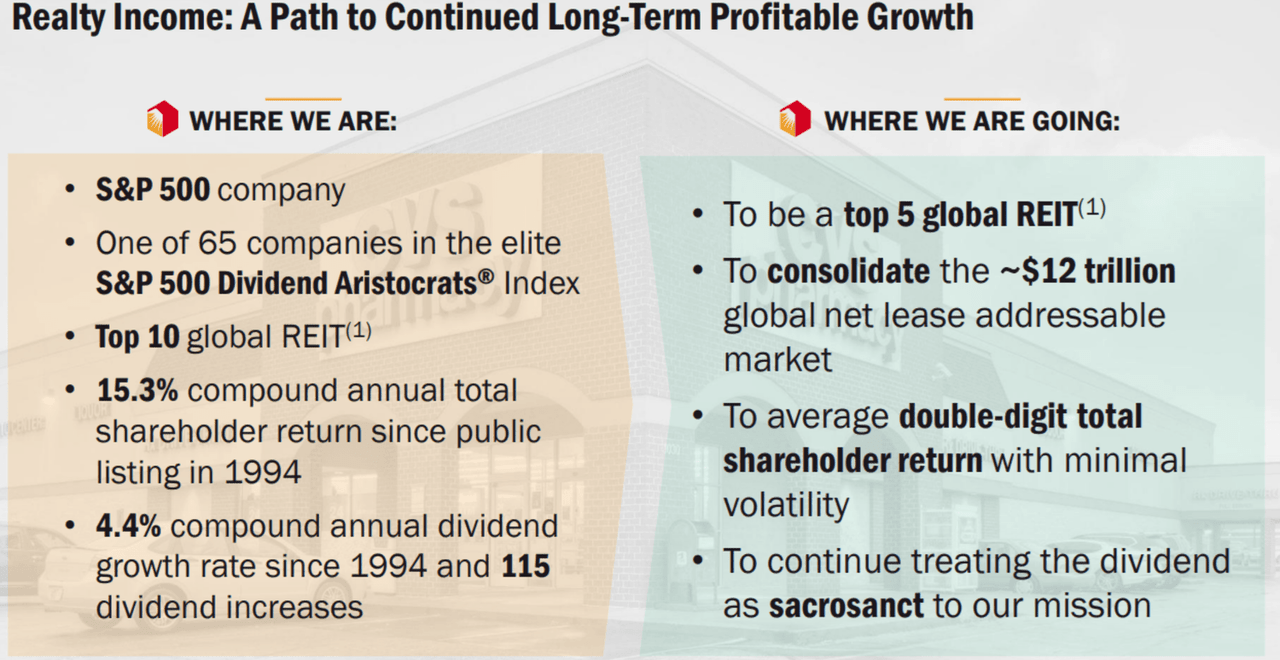
The company’s portfolio consists of more than 6,700 properties that generate rental revenue from long-term lease agreements with commercial tenants (such as Walgreens, CVS and Dollar Tree, to name a few).
Realty Income Investor Presentation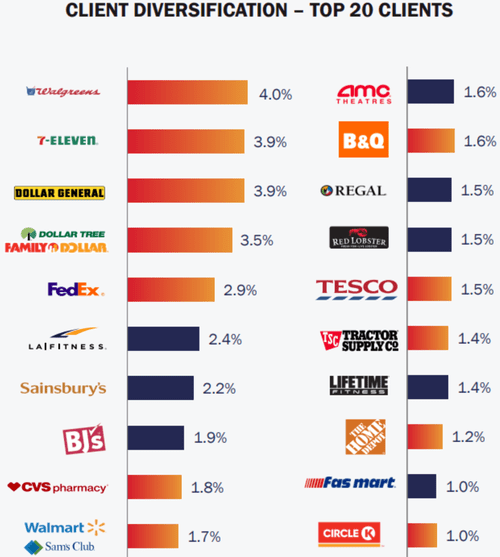
The portfolio is diversified across tenants, industries and geographies. Nearly 96% of its rental revenue comes from tenants with a nondiscretionary service and/or a low price point component to their business. These tenants are resilient to economic downturns and significantly isolated from e-commerce pressures (from the likes of Amazon, for example).
Realty Income Investor Presentation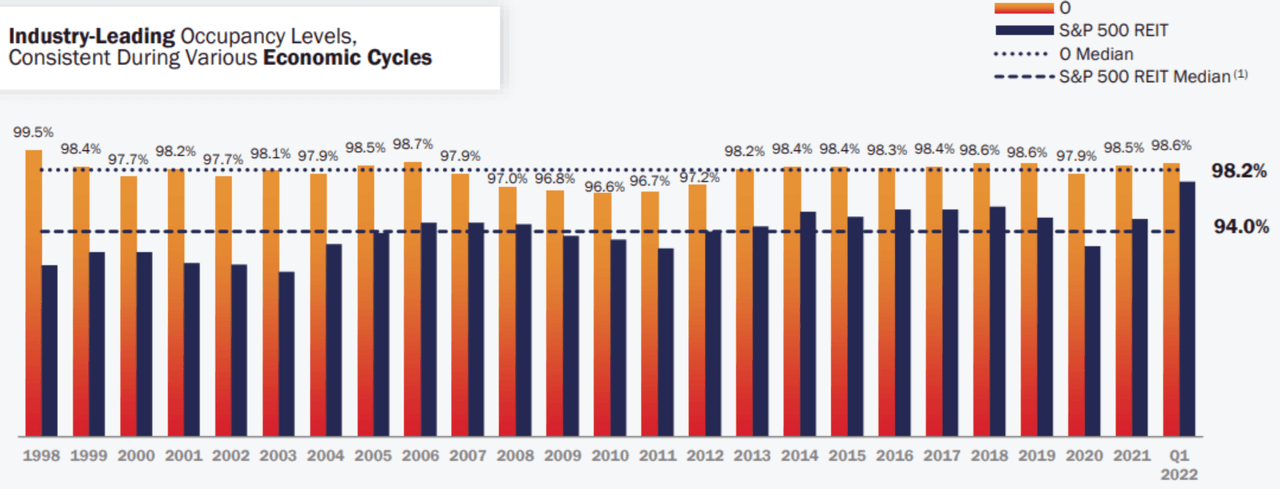
Business Strategy
As one of the most stable and financially strong REITs in its space, Realty Income increasingly looks to acquisitions as a big part of its growth strategy.
Realty Income Investor Presentation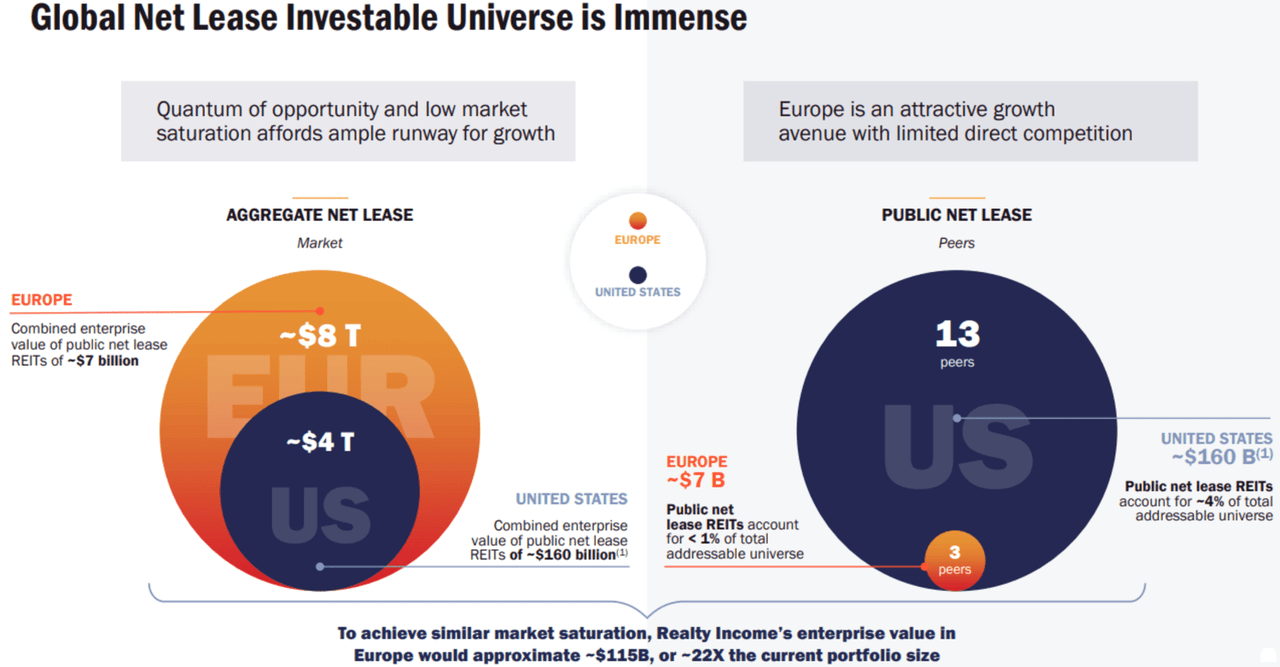
And it has the financial wherewithal to do this (for example, Realty Income is one of only seven U.S. REITs with two A3/A- ratings or better). Plus, the environment remains attractive for such a strategy considering the market is highly fragmented and because this year’s economic challenges may leave increasing acquisition targets in some distress (i.e. a better time to get good deals on potential acquisitions).
For example, Realty Income’s recent large strategic merger with VEREIT created a premier net lease REIT with increased size and scale, supporting long-term growth through consolidation of a highly fragmented net lease industry.
Risks:
Of course, Realty Income’s business does face risks. For example, the business is very large already (as compared to other REITs, see REIT comparison table later in this report) and this can make it challenging to grow at scale (thus the increasing acquisition strategy as described above). Another risk is simply interest rate risk. Specifically, Realty Income has long-term tenant leases with built in rent escalators, but the escalator increases are small and high inflation could pressure margins. This could create challenges, but as the company takes on new acquisitions, rates may be commensurate with the market, and the old rates will eventually roll off and be replaced.
50 Big-Dividend REITs, Compared:
Before getting into more detail on valuation, here is a look at some important metrics on 50 big-dividend REITs. The table is organized by REIT industry, and as you can see-there has been some pretty ugly performance so far this year for most REITs, but not for Realty Income.
blueharbinger.com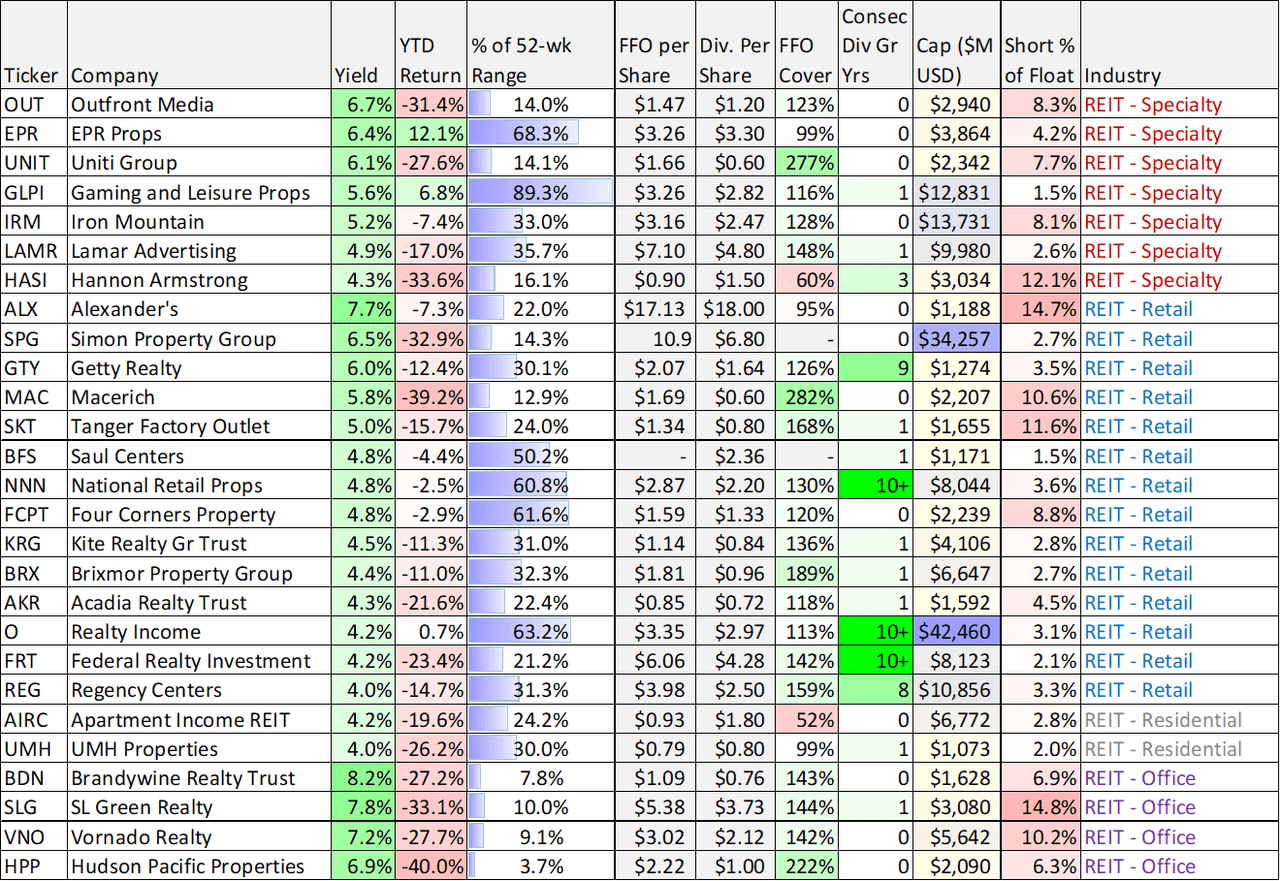
data as of 21-Jul-22 (blueharbinger.com)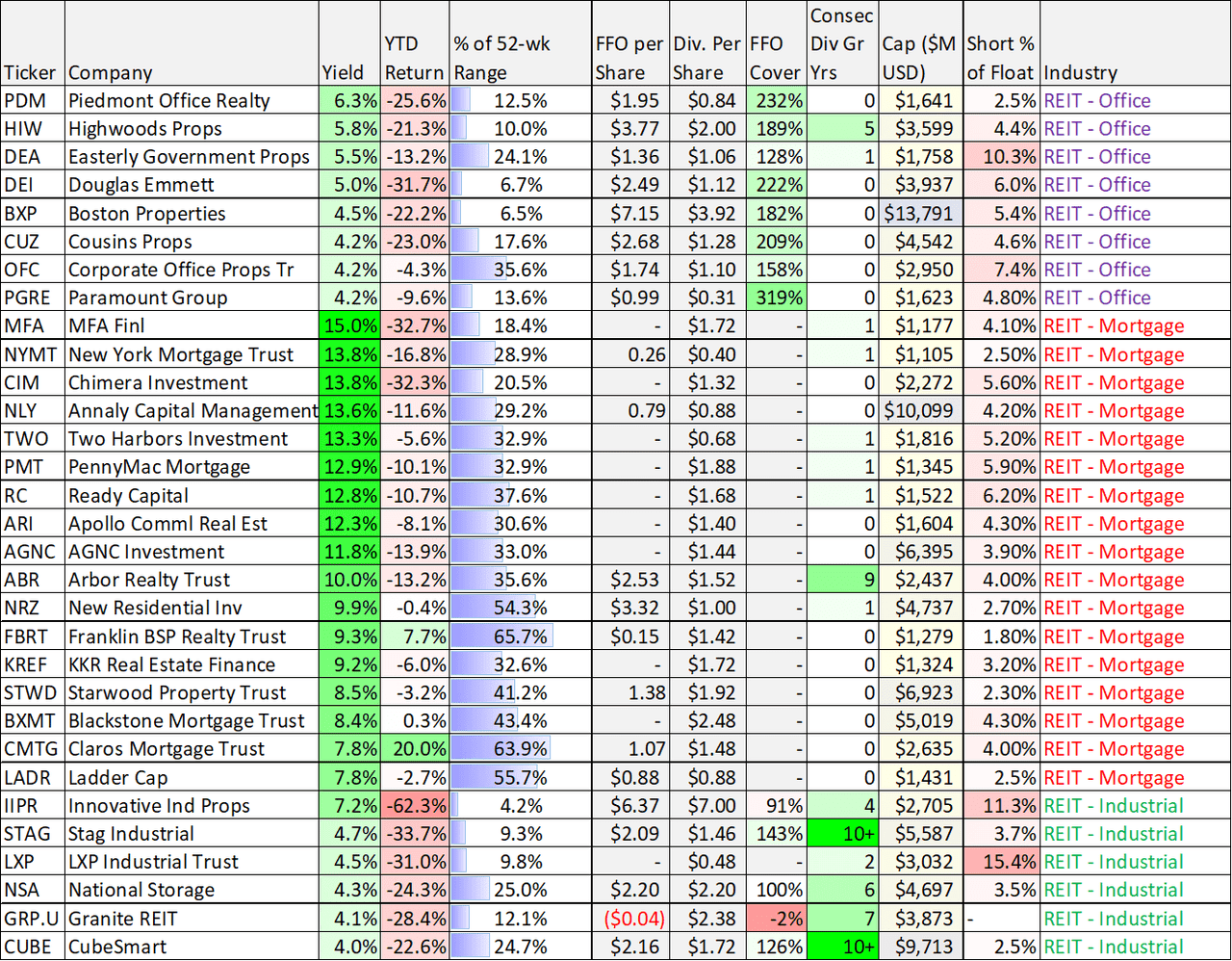
You probably see at least a few of your favorite REITs in the table above (such as Simon Property Group (SPG), W. P. Carey (WPC) and Iron Mountain (IRM). And just some brief observations: (1) Office REITs have been challenged as more people are able to work from home, (2) Mortgage REITs (like AGNC (AGNC) and Annaly Capital (NLY)) are facing growing challenges as rising rates are creating book value challenges, and (3) After a great multi-year run, industrial REITs (like Stag Industrial (STAG) are down as the pandemic supply chain changes that benefitted them have now slowed.
Valuation:
From a valuation standpoint, Realty Income is relatively expensive compared to some peers, but not expensive as compared to its value.
For starters, Realty Income trades at a higher price-to-Adjusted-FFO multiple (this year and next) than many of its peers, simply because it is a stronger healthier business (i.e. less risk). In part, the multiple is also stronger because the price of Realty Income has outperformed most other REITs so far this year (as the market has sold off) because of the strong “blue chip” nature of its business.
Here is a look at Realty Income’s recent adjusted price-to-FFO multiple as compared to peers.
Essential Properties Realty Trust (EPRT) Investor Presentation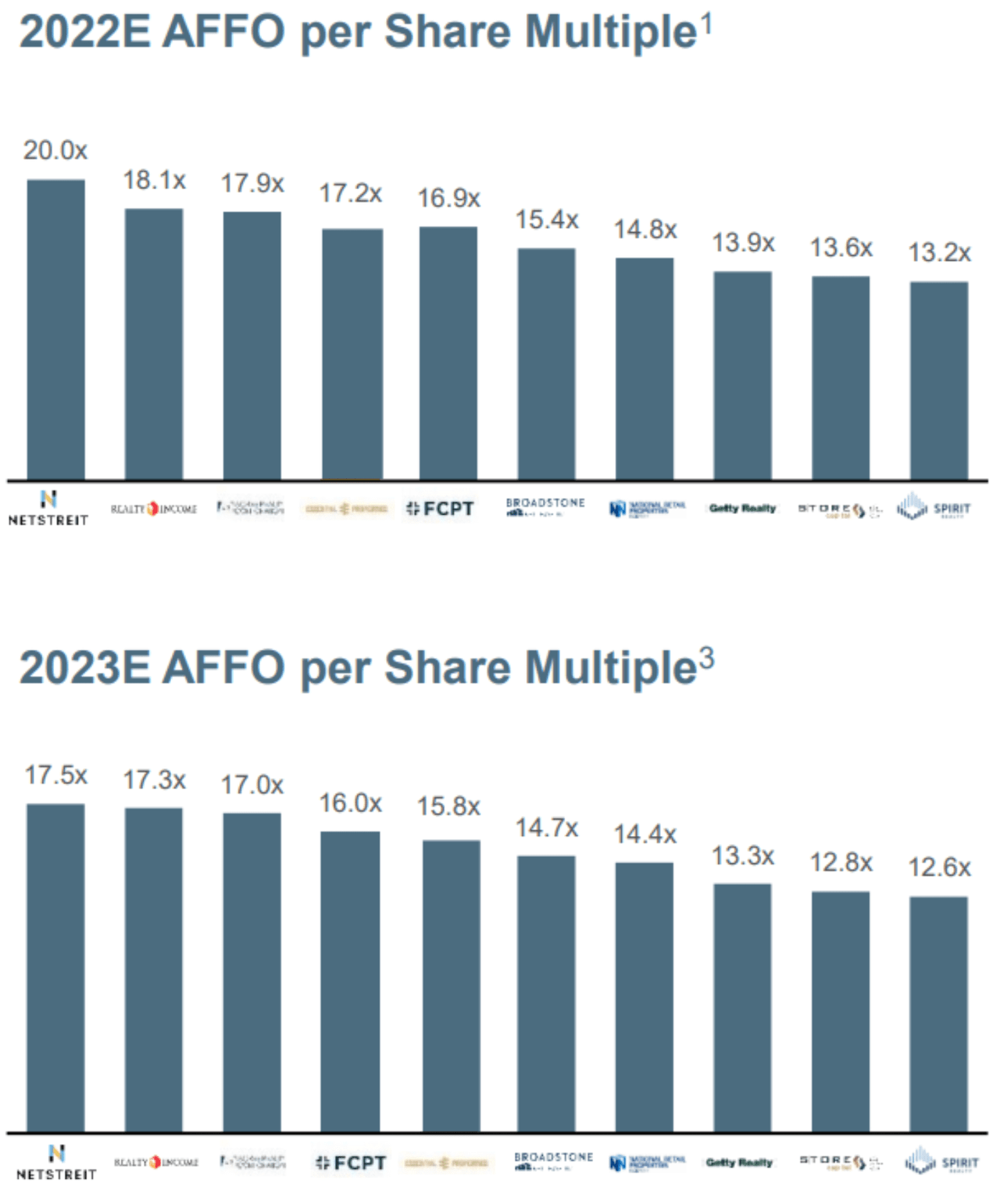
Again, Realty Income is not particularly inexpensive as compared to peers, but this is because Realty Income is considerably healthier. It is also very important to note from a valuation standpoint, Realty Income still has positive expected growth in Adjusted Funds From Operations this year and next (a good thing), as you can see in this next chart.
Essential Properties Realty Trust (EPRT) Investor Presentation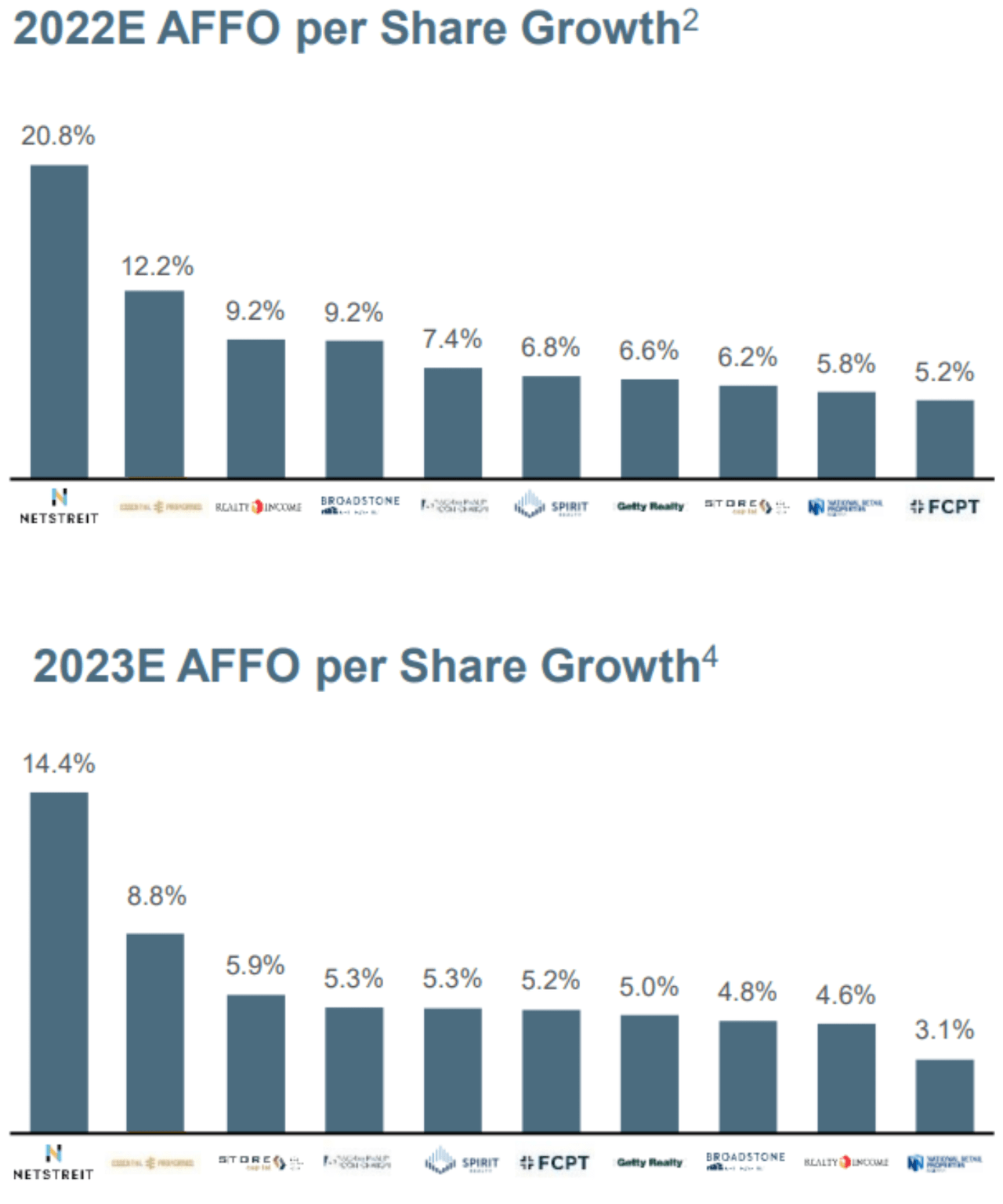
And as Realty Income grows its acquisition pipeline, the expected growth for 2023 (see chart above) will likely rise (a good thing for Realty Income).
And for reference, here is Realty Income’s AFFO multiple earlier this year, and you can see it has come down a bit (good for “buy lower” long-term contrarians).
Spirit Realty Earnings Call Presentation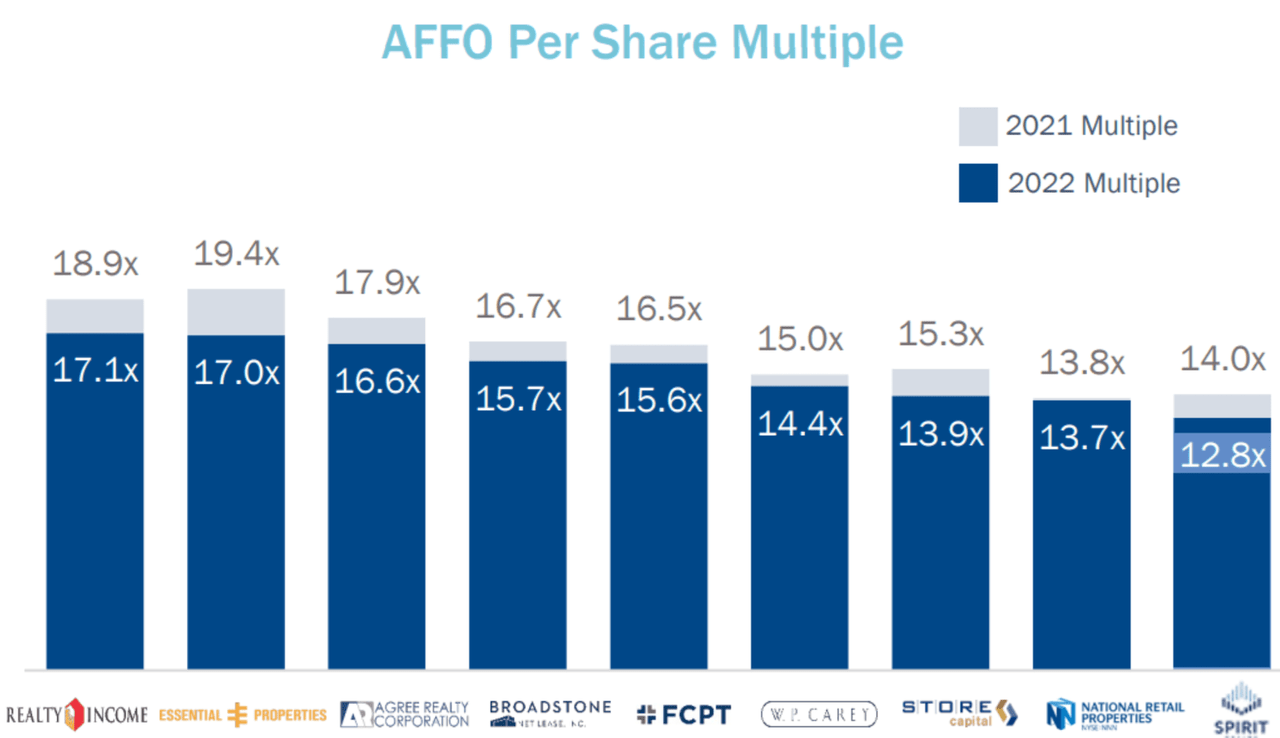
And very importantly, you can see in this next chart that Realty Income’s valuation is also attractive by historical standards. For example, recent FFO per share exceeds levels before the pandemic, yet the share price does not, another indication that Realty Income currently trades at an attractive price-to-FFO multiple.
YCharts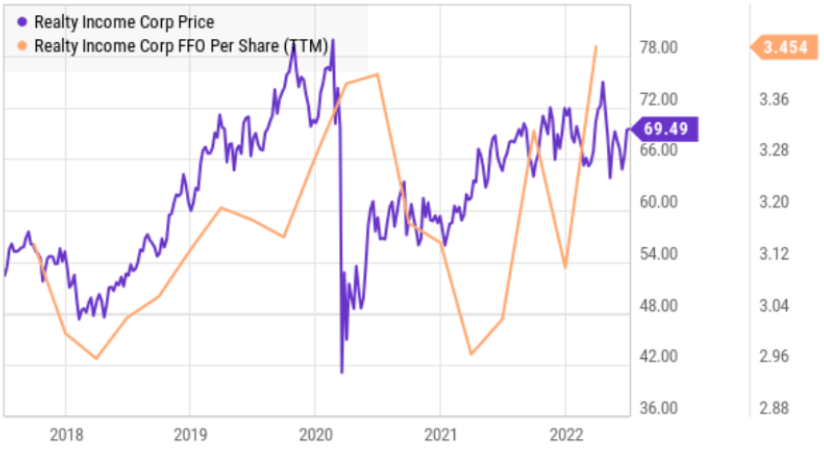
Realty Income Versus Dividend Aristocrats
Comparing Realty Income to its dividend aristocrat peers (i.e. S&P 500 companies that have also increased their dividend for at least 25 years in a row) provides interesting perspective and insights. For starters, here are the dividend aristocrats, including important metrics like dividend yield, market cap, short interest and performance.
blueharbinger.com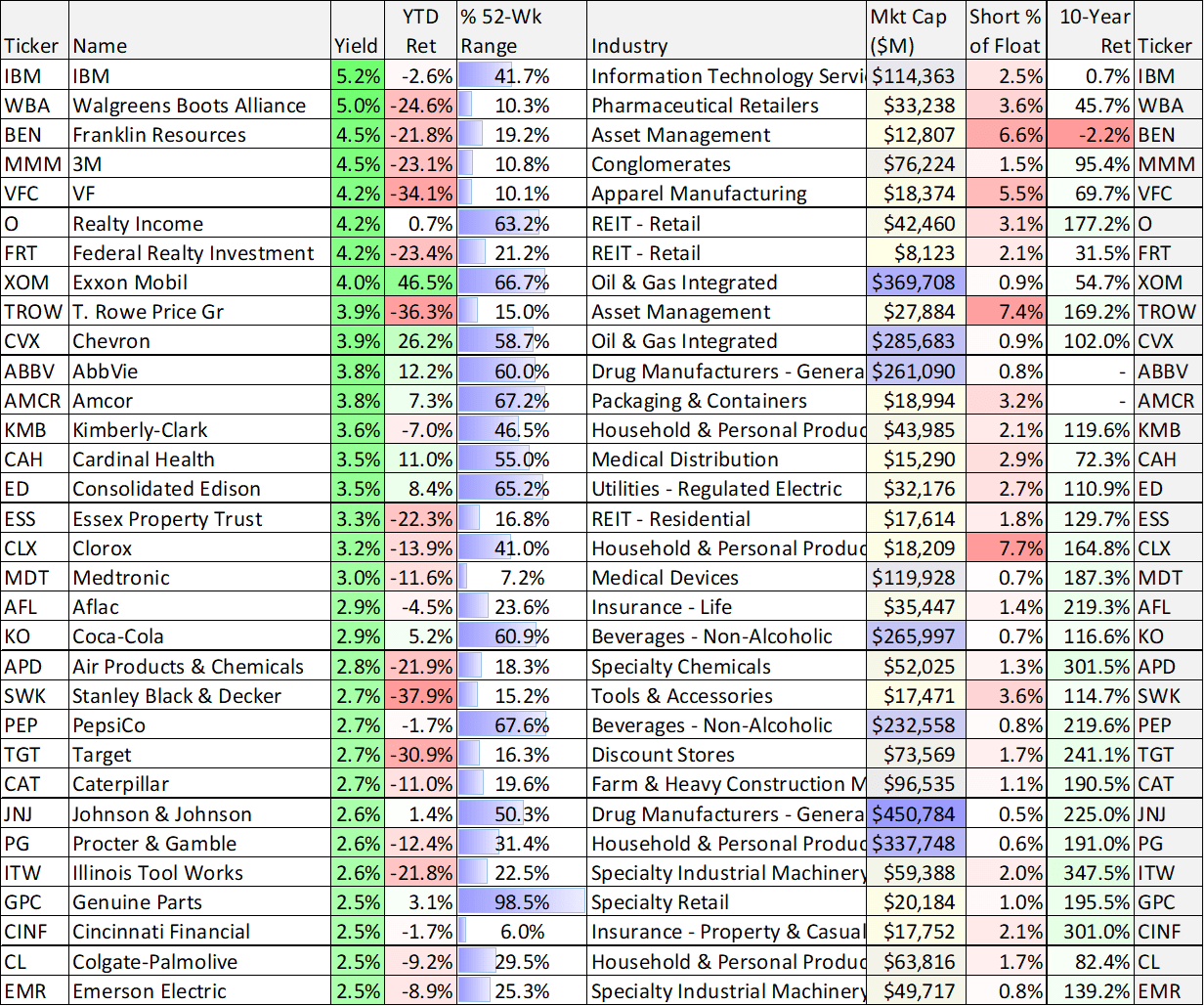
data as of 21-Jul-22 (blueharbinger.com)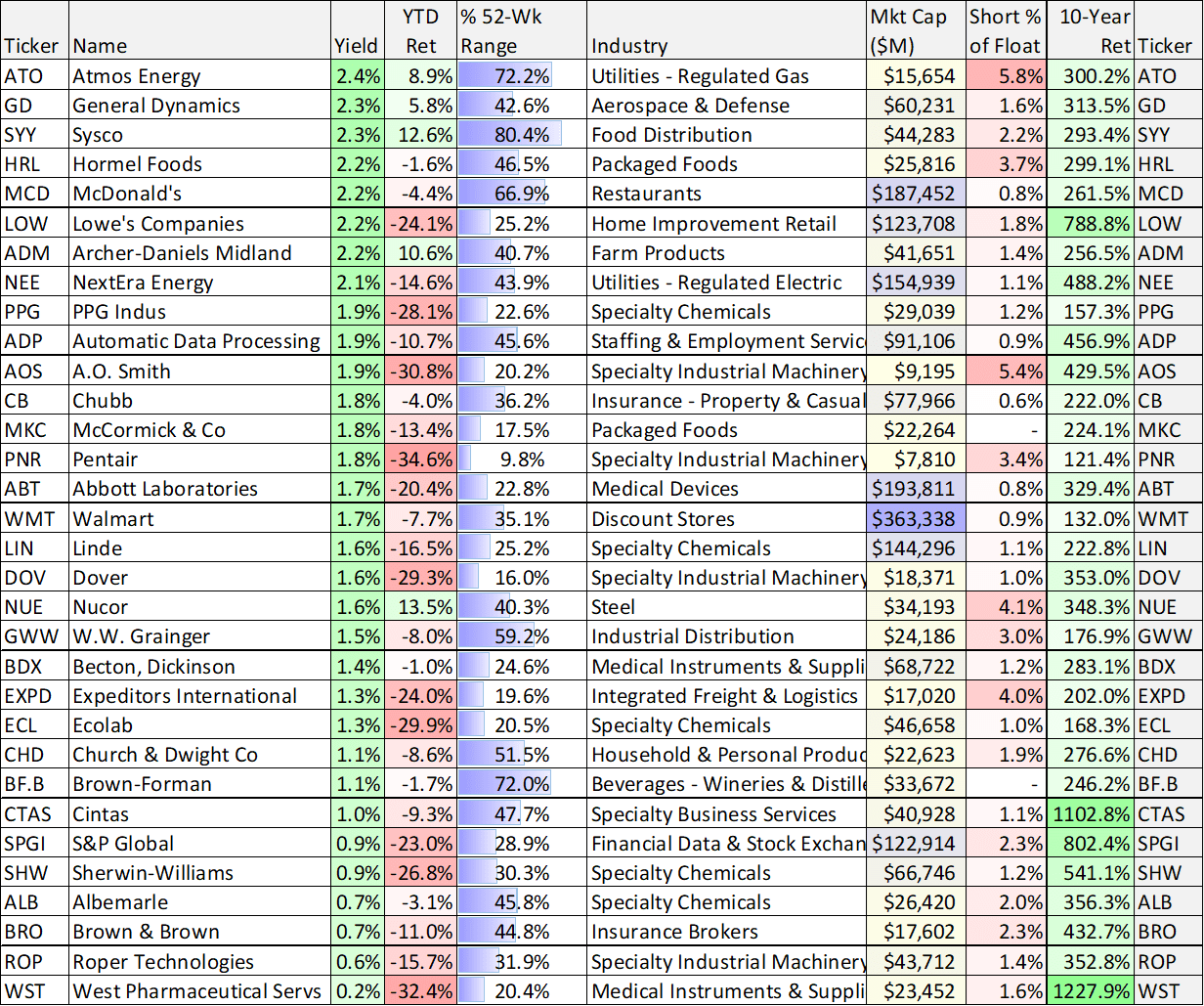
As you can see in the table above, not only does Realty Income have the 6th highest dividend yield in the group (the table is sorted by dividend yield), but it has also delivered a positive total return this year (something most companies on this list have NOT been able to do). This is a tribute to Realty Income’s stability in times of volatility.
Another important metric is 10-year performance. You may notice that the companies with the best 10-year performance generally have the lowest dividend yields-this should be a reminder to not chase after stocks just because they offer high dividend yields. As we wrote in our previous report (7 Deadly Sins of Long-Term Investing):
“Few things frustrate us more than when an investor assumes an investment with a higher yield must be better than an investment with a lower yield. We call this “yield chasing” and it is a bad idea.
Investments with very high yields are often a red flag, and an indication of a company in distress. It can signal a dividend cut on the horizon and potentially even a bankruptcy for the company. Rather than chasing the highest yields, investors should focus on the best yields.”
Nonetheless, Realty Income has managed to post a very respectable 10-year return while it has also delivered a strong dividend (recall from our earlier table, Realty Income’s dividend is well covered by funds from operations).
The Bottom Line:
In our view, Realty Income remains attractive for a variety of reasons, including its very strong financial position, its prudent acquisition-focused business strategy, its incredible dividend-growth (and safety) and its attractive current valuation. Not to mention, the outlook for its real estate business remains attractive because of the prime location properties that are largely not vulnerable to the online shopping trend that other types or REITs face (for example shopping malls).
And despite the shares relative strength this year, and despite the risk factors (such as rising rates and conservative rent escalators), we continue to believe Realty Income presents a very attractive investment opportunity for steady income-growth (and price appreciation) investors. We are currently long shares of Realty Income (along with three additional attractive REITs) in our Income Equity portfolio (which is trouncing the S&P 500 this year), and we have no intention of selling.


Be the first to comment